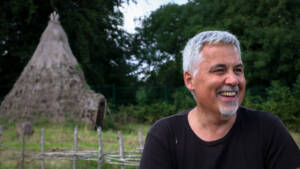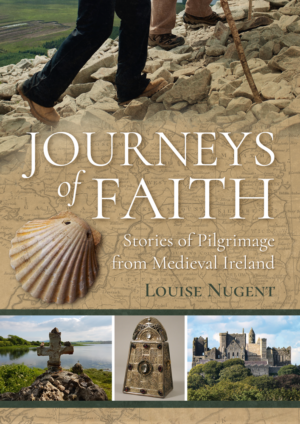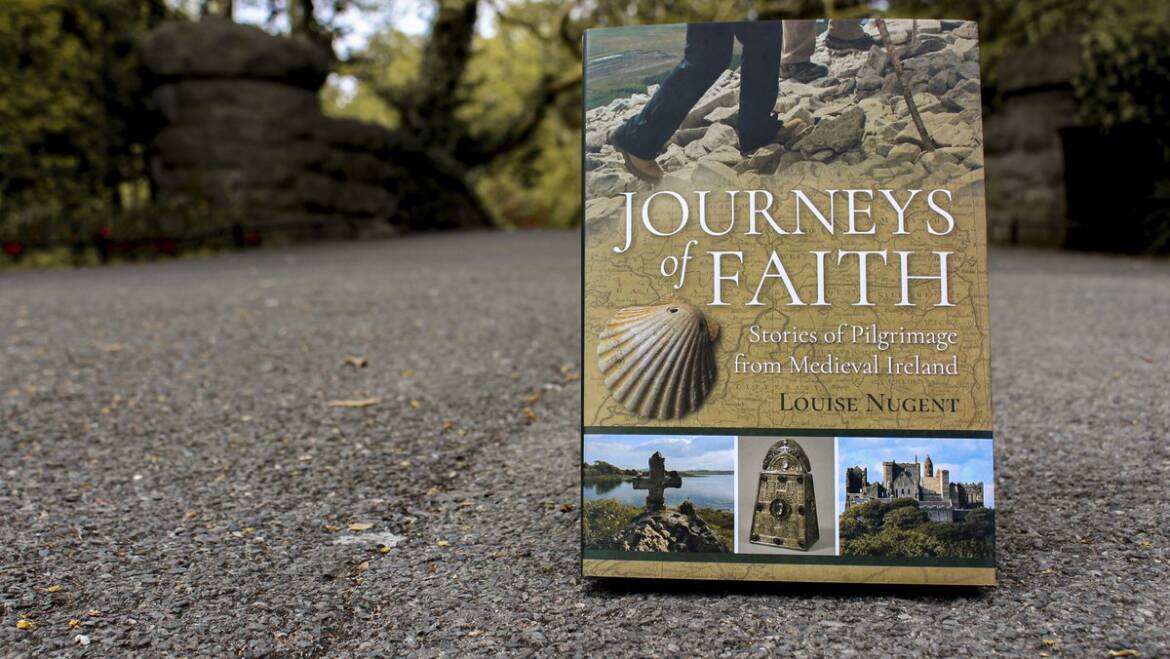Journeys of Faith: Stories of Pilgrimage from Medieval Ireland is a fascinating, marvellous, and wonder-filled book, the baseline for all future scholarly studies of Irish medieval pilgrimage, and will also be welcomed by anyone interested in what it was like to live in the medieval world. Written by Dr Louise Nugent the leading scholar on Irish medieval pilgrimage, it is reflective, scholarly, rich in anecdotal historical and archaeological detail, and lavishly illustrated with top-class photographs (and some terrific artistic reconstructions of pilgrims’ activities), maps of landscapes, sites and material culture associated with pilgrimage from the 7th century to the Reformation.
It sets the scene by laying out the destinations of Irish pilgrimage, both in Ireland and beyond (e.g. Jerusalem, Rome, Santiago de Compostela, and many sites in Britain). It then explores the motives behind the medieval pilgrim’s journey (e.g. faith, devotion, healing, seeking of indulgences, penance, crisis, adventure and tradition). We read of the practical and spiritual preparations for travel, the permissions sought and the equipment gathered, and for long-distances the wearing of clothes signalling to strangers one’s pilgrim status, including a wooden staff, a scrip (a leather purse or satchel), and hat. The practicalities of travel in medieval Ireland are detailed, the roads travelled (and its perils), the accommodation sought, and the individual experiences of particular pilgrims, such as that of Heneas MacNichaill in 1543/44, after murdering his own son are suggested.

Individual pilgrim routes in Ireland are tracked, including the Tochar Phadraig, Co. Mayo (and the many photographs indicate that the author has gone on many journeys herself!). We then read of the Irish pilgrims travelling outside Ireland, building on the rich historical accounts of monasteries, hostels, the routes developed (and their perils and dangers), as well as the long journeys made to European centres of pilgrim worship and devotion. What did pilgrims do on arrival? We read of the ‘patterns’ of worship, the encounters with saints’ relics, the shrines and leachta visited, the processions, practices and prayers adopted and used.
Finally, the book concludes by reflecting on how the pilgrim’s journey transformed the person, how a man or woman might be considered as a ‘pilgrim’ for the rest of their lives. This can best be seen by the things associated with long-distance pilgrimage, the badges, ampulae (small metal containers that held oil or water from the shrine), and scallop shells (as I write this, I can see my own scallop shell, bought in a shop beside the cathedral, after my own walk on the Camino to Santigo de Compostela, in NW Spain).
Throughout the book there is that sense of awareness of the modern revival of pilgrimage, and the journeys made by hundreds of thousands every year along ancient pilgrim ways in Ireland and Europe – a classic example being Dr Nugent’s detailing of modern pilgrimage at the ancient site of Tigh Moling (the modern St Mullins, Co Carlow). A comprehensive bibliography is included.
In conclusion, this book is for everyone, to be read, dipped into and enjoyed, especially in this harsh Covid-19 time when we are limited in our personal potential for travel. Indeed, anyone seeking to enrich their own experience of a sometime thence pilgrim’s journey to where-ever that might be, should buy and read this book!
Professor Aidan O’Sullivan, UCD School of Archaeology, University College Dublin

Journeys of Faith by Dr Louise Nugent is available here.

